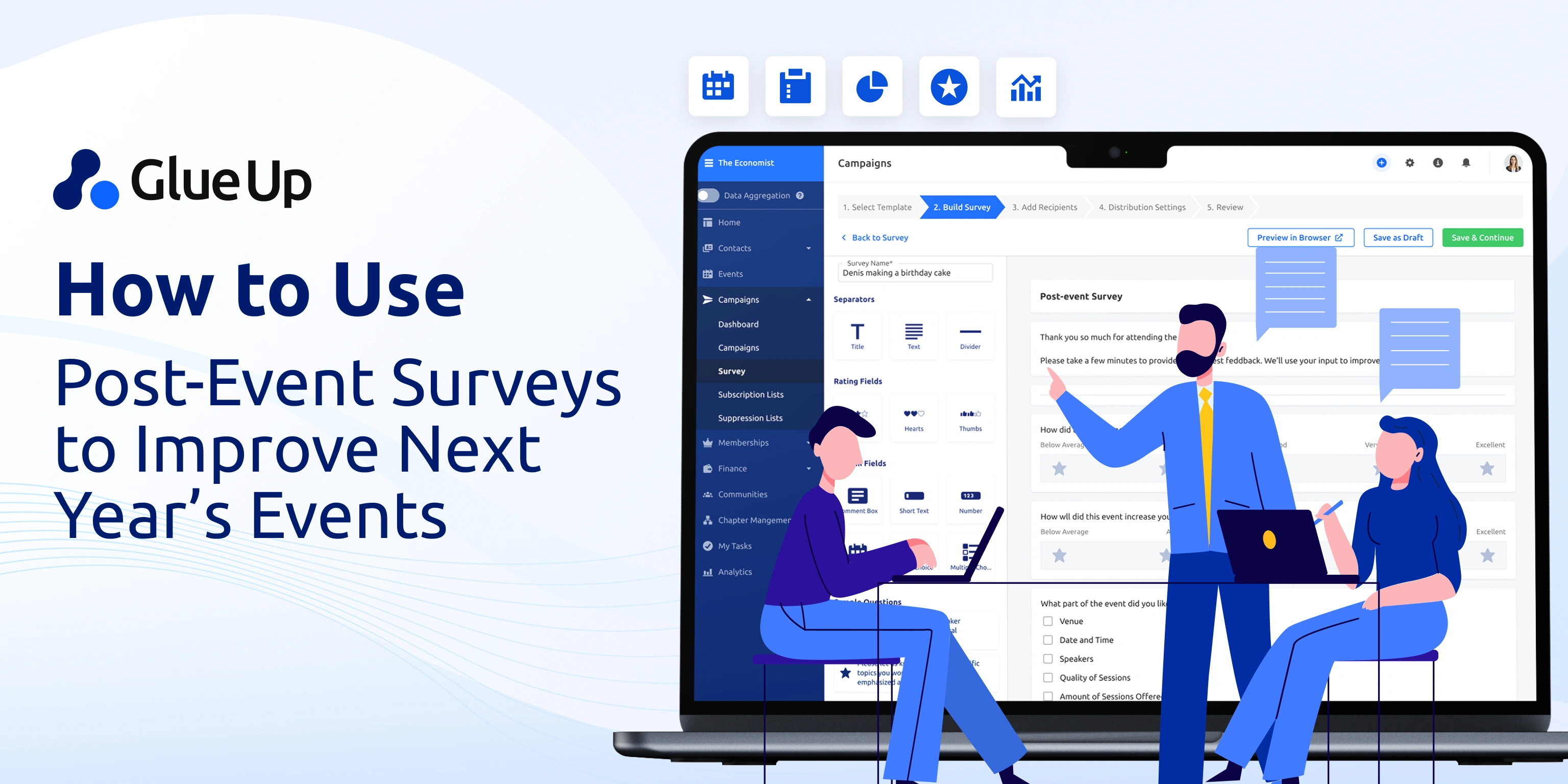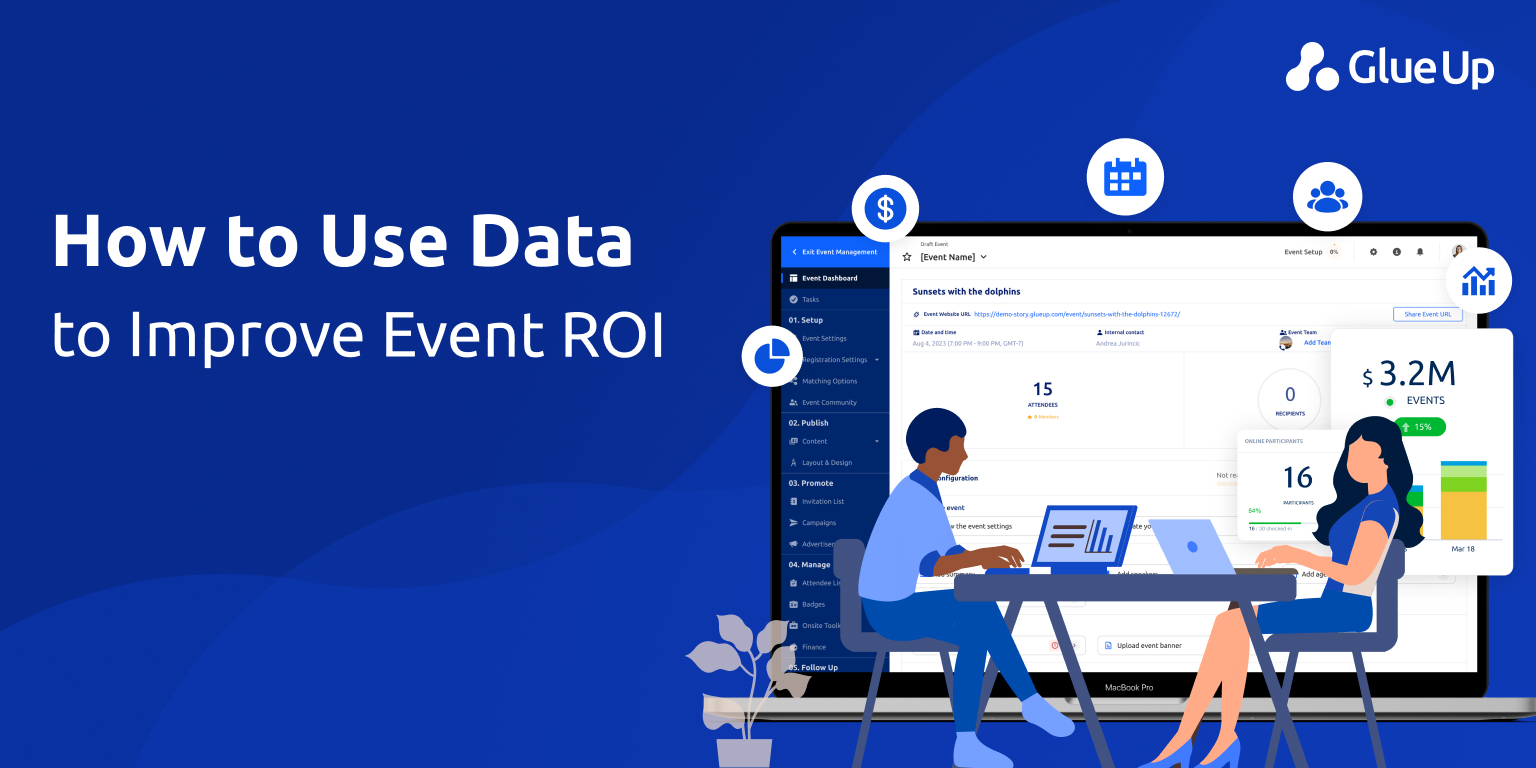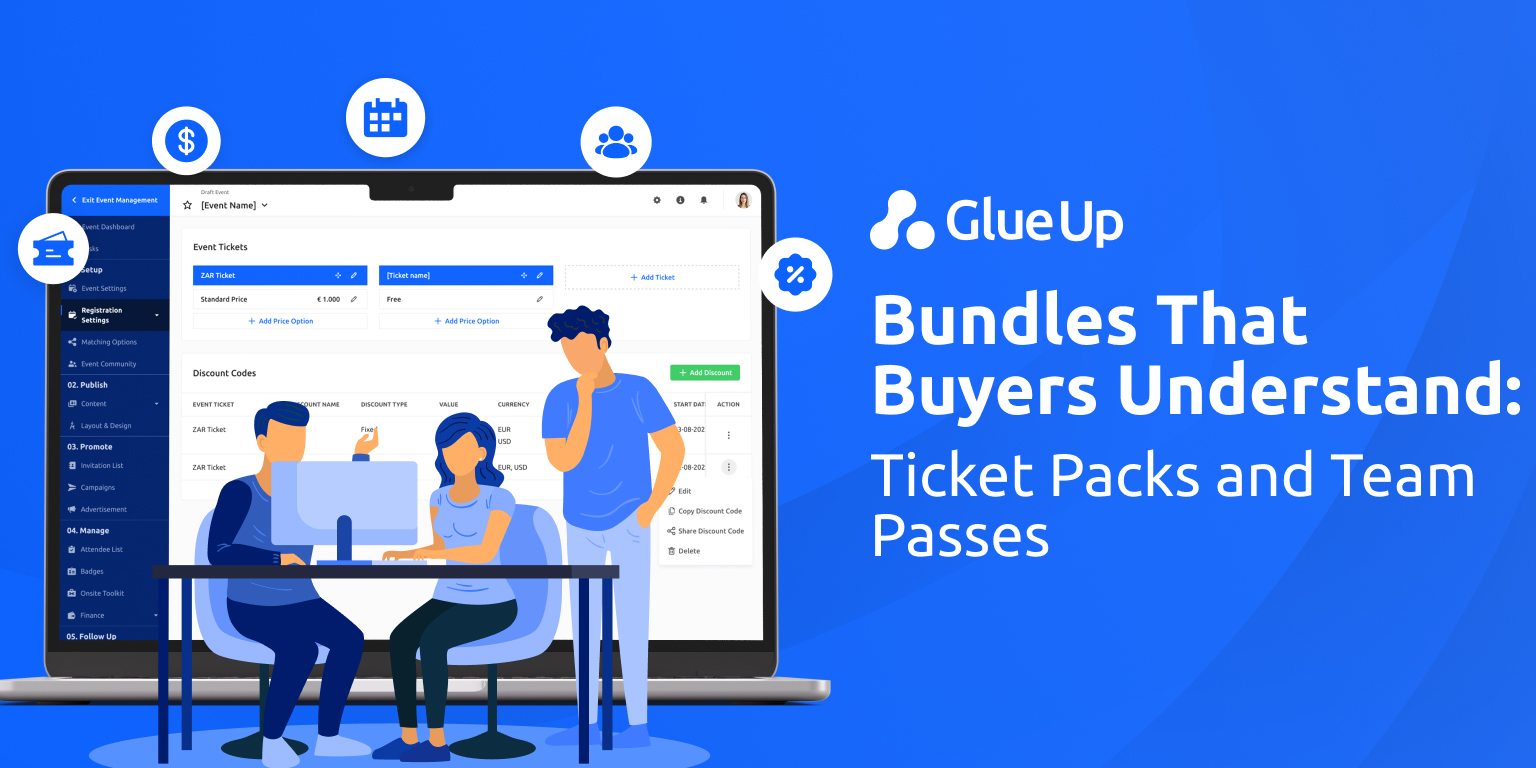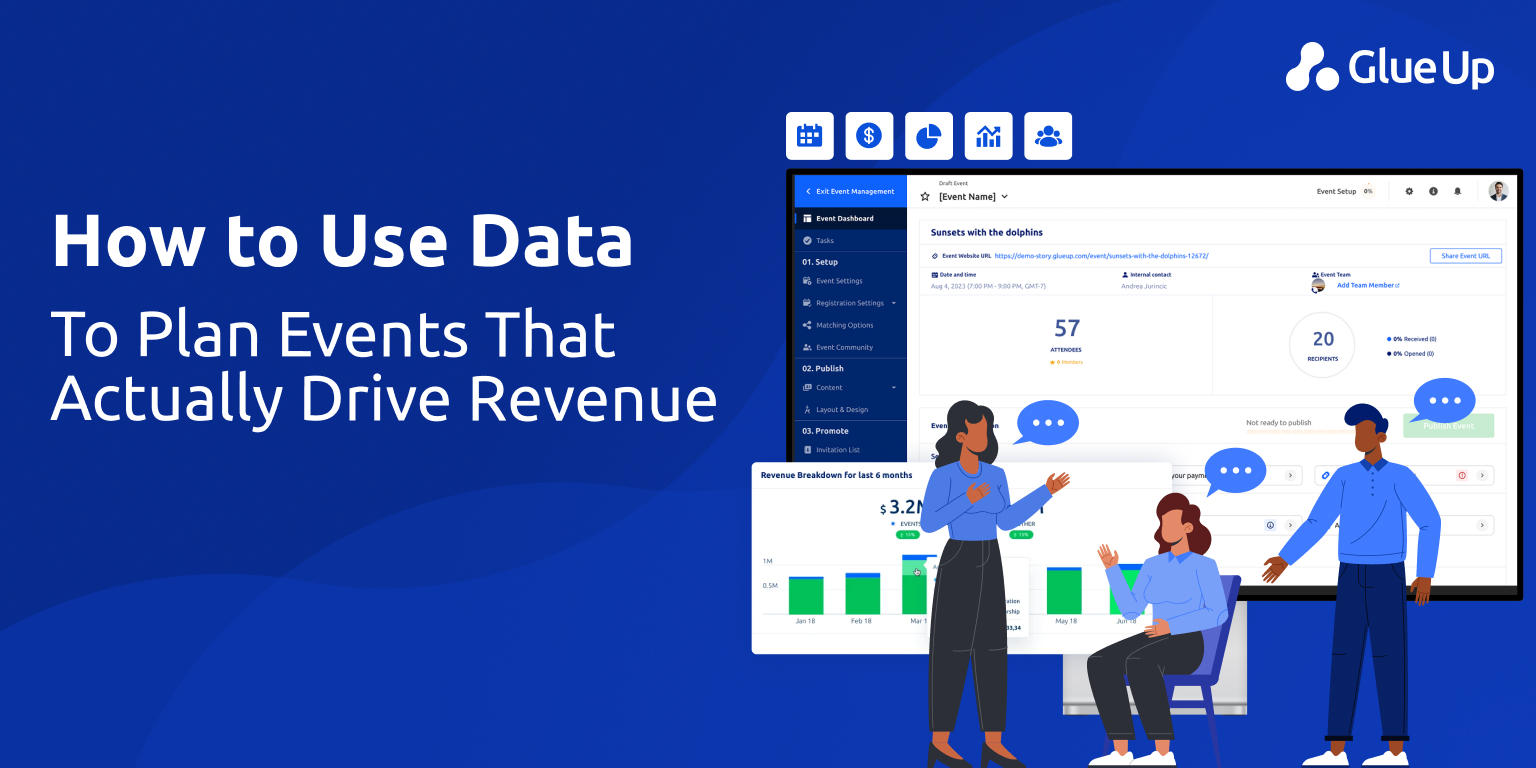
You already know an event’s success isn’t measured by applause but by insight. Every gala, policy forum, or annual conference you run produces data, and how you capture it determines how quickly you improve. A well-designed post-event survey turns feedback into strategy, translating opinions into measurable performance indicators across engagement, content, and ROI.
For associations, that data becomes operational gold. It shows where experiences exceeded expectations and where the next cycle needs refinement. According to SurveyMonkey, organizations that standardize post-event feedback see up to a 30% lift in satisfaction and significantly stronger repeat attendance.
In this guide, you’ll learn how to design effective post-event survey questions, interpret responses across stakeholder groups, and use Glue Up’s event management software to automate collection, integrate analytics, and turn post-event insights into year-over-year growth.
For a quick overview, watch the video below and book a demo to see how our platform supports data-driven event strategies that compound value every year.
Key Takeaways
- A well-designed post-event survey transforms feedback into measurable insights that improve future events.
- Segment questions for attendees, staff, speakers, and sponsors to capture diverse perspectives.
- Short, mobile-friendly surveys improve completion rates and data accuracy.
- Integrating surveys into your event management software connects satisfaction metrics to attendance, ROI, and engagement.
- Glue Up’s survey software automates distribution, analysis, and reporting to make continuous improvement effortless.
Why Post-Event Surveys Matter for Long-Term Event ROI
Every event you host delivers two products: an experience and a data set. The experience builds perception; the data builds progress. The problem most associations face isn’t collecting relevant feedback but structuring it to drive measurable improvement. A post-event survey acts as your bridge between perception and performance, converting opinions into analytics that reveal what truly worked.
Research from Race Roster shows that events leveraging structured post-event analysis see stronger sponsor retention, higher attendance consistency, and a 20% improvement in NPS scores year over year. When you translate participant sentiment into action, your event strategy becomes self-optimizing.
Measuring What Matters: Satisfaction as a Strategy
Post-event feedback shouldn’t focus only on satisfaction scores. You need insight into behavioral outcomes — renewal intent, advocacy interest, and event recall. According to Events.org, organizations that prioritize relevance over length in surveys receive up to 50% higher response rates. That higher participation gives you a more accurate view of engagement economics, i.e., what experiences truly drive perceived value among members, sponsors, and staff.
A strategic post-event satisfaction survey for attendees should measure:
- Engagement quality: Did programming match professional needs and time value?
- Experience accessibility: Were check-in, venue, and session transitions seamless?
- Content relevance: Did sessions address current industry challenges?
- Networking value: Did attendees make meaningful new connections?
The objective isn’t to validate success; it’s to quantify it.
Connecting Insights to Operations
For most associations, the biggest gap lies not in collecting data but in connecting it. Feedback often sits in spreadsheets, disconnected from CRM or finance systems. Without integration, you can’t link attendee satisfaction to renewals, sponsorship renewals, or membership engagement.
This is where event intelligence replaces event reporting. By integrating post-event feedback directly into your event management software via survey tools, you can visualize correlations between satisfaction, participation, and financial outcomes. Dashboards convert raw feedback into trend lines, showing exactly which sessions, speakers, or formats drive retention and ROI.
The Strategic Payoff
When you treat feedback as an operational process rather than a post-event courtesy, you shift from evaluation to prediction. Each survey informs how you allocate resources, price sponsorships, and design experiences that sustain engagement across your entire event portfolio. Over time, that precision compounds, driving higher renewal rates, stronger partnerships, and measurable year-over-year performance improvement.
The next step is application: how to design, structure, and distribute post-event surveys that produce data you can actually act on.
Designing Post-Event Surveys That Deliver Actionable Insight
Designing an effective post-event survey is less about asking questions and more about asking the right ones. Each question represents a decision waiting to be made — about programming, engagement, sponsorship, or experience design. The key is structure: clarity in purpose, precision in wording, and alignment with measurable outcomes.
Start with the Objective: Define What You Want to Learn
Before you draft your first question, determine what success looks like. Are you measuring attendee satisfaction, content quality, or logistical performance? Identify three categories of intent before survey creation: satisfaction, improvement, and loyalty. This structure prevents redundancy and ensures your data translates directly into operational next steps.
For example:
- To measure satisfaction, ask: “How would you rate the overall event experience?”
- To drive improvement, ask: “Which sessions or elements would you change for future events?”
- To assess loyalty, ask: “How likely are you to attend another event organized by our association?”
Every question should map back to a performance indicator in your event plan, whether it’s event ROI, attendance conversion, or sponsorship value.
Segment by Stakeholder: Attendees, Staff, and Speakers
Different stakeholders experience your event differently, which means your post-event satisfaction survey must be segmented accordingly. A one-size-fits-all form dilutes insight and creates noise in your data.
For Attendees
Attendees judge events based on personal value and accessibility. Focus on questions related to logistics, content relevance, and engagement quality.
Example:
- “Were sessions aligned with your professional interests?”
- “How satisfied were you with the ease of registration and check-in?”
For Staff
Your operations team views the event as a process. Ask about efficiency, collaboration, and tool performance.
Example:
- “Did our event management tools streamline your workflow?”
- “Where did bottlenecks occur during setup or execution?”
For Speakers and Sponsors
Speakers value audience engagement and technical reliability; sponsors measure brand exposure and lead quality.
Example:
- “Did the technical setup meet your presentation needs?”
- “Were sponsor deliverables communicated and fulfilled effectively?”
Optimize for Completion: Timing, Length, and Accessibility
A well-designed survey loses value if no one completes it. The data shows that engagement drops after the fourth question and conversion rates decline when surveys exceed five minutes. To maximize response rates:
- Distribute your survey within 24 hours of the event while impressions are fresh.
- Keep the total length under 10 questions.
- Use mobile-friendly formats compatible with email and SMS delivery.
Use Scales and Open-Ended Questions Strategically
Quantitative questions provide comparability; open-ended ones provide depth. Pairing the two gives you both precision and perspective. For example:
- Use a 1–10 satisfaction scale for measurable metrics like content quality or venue convenience.
- Follow up with open-ended prompts like “What would make this event more valuable to you?”
Automated analysis tools can then categorize responses by sentiment, helping you identify recurring themes without manual sorting.
Connect the Survey to Your Event Ecosystem
Your survey data should not exist in isolation. Integrating it into your event management software ensures insights translate into actionable plans. Glue Up connects post-event responses directly to member profiles, event dashboards, and communication workflows so that you can correlate satisfaction with attendance, renewals, and engagement behavior.
Once feedback becomes part of your event intelligence loop, it informs programming decisions, sponsorship pricing, and content direction for future events.
The next section will focus on what to do after you collect this data: how to analyze, communicate, and implement the findings to drive measurable improvement in the next event cycle.
Turning Feedback Into Strategy: How to Apply Post-Event Insights for Continuous Improvement
Collecting responses is easy, especially with powerful member engagement tools on Glue Up. However, turning them into measurable improvement is where leadership begins. The value of a post-event survey lies in its execution — how well you interpret, communicate, and embed insights into the next planning cycle. Done right, feedback becomes a form of governance, aligning your team around evidence rather than assumptions.
Translate Data Into Decision Points
Once you’ve gathered your survey results, the first step is to convert qualitative responses into quantifiable indicators. Patterns in ratings, comments, and NPS scores reveal operational truths: which sessions created impact, which formats underperformed, and which logistics caused friction.
For example, if attendee satisfaction correlates strongly with speaker ratings but poorly with networking outcomes, you’ve uncovered a structural gap, not a one-time issue. Mapping this insight against event data (attendance, engagement, and sponsor ROI) gives you clarity on what drives results.
With Glue Up, you can tag and categorize post-event feedback survey responses by topic or theme, so your team can analyze them alongside event metrics without manual sorting. You move from anecdotal summaries to actionable dashboards.
Communicate Insights Across Stakeholders
Data loses power when it stays internal. Share your findings with stakeholders in formats that drive collaboration.
- For Boards: Present summaries tied to financial and engagement KPIs. Link satisfaction data to event ROI and renewal projections.
- For Sponsors: Highlight audience engagement and sentiment data to demonstrate brand value.
- For Teams: Focus on execution feedback — what worked, what didn’t, and what to refine next time.
Using post-event analytics in this way builds a culture of transparency and accountability. When feedback flows across departments, your association begins learning as a system.
Build Feedback Loops Into the Planning Process
Improvement only compounds when feedback informs action. Integrate survey results directly into your event planning workflow. For example:
- Update your session selection criteria based on satisfaction scores.
- Adjust staffing levels or venue design according to accessibility feedback.
- Prioritize recurring themes when setting next year’s agenda.
Glue Up’s event management software automates this process. You can attach survey summaries to event blueprints, so each new cycle starts with evidence, not memory. This continuity ensures knowledge transfer even when leadership or committees change.
Monitor Long-Term Trends
Event feedback becomes exponentially more valuable when tracked over multiple cycles. Benchmark your results annually: Are satisfaction scores rising? Are certain attendee segments disengaging? Is sponsor ROI improving in tandem with participation rates?
With Glue Up’s analytics dashboards, you can visualize satisfaction trends, filter results by attendee type, and identify long-term performance shifts. These insights reveal not just what improved but why, helping you plan proactively rather than reactively.
Operationalize Learning for Strategic Growth
The ultimate goal of post-event evaluation is strategic maturity, the ability to use data to forecast outcomes, not just measure them. When your team views surveys as operational instruments rather than administrative tasks, you elevate your event function into a strategic growth engine.
With every survey, you refine predictability, strengthen engagement, and build organizational intelligence. That’s what defines high-performing associations: the discipline to listen, the structure to act, and the systems to sustain both.
The Glue Up Difference: Automating Post-Event Intelligence
Glue Up simplifies every part of your event lifecycle by connecting event registration, member communication, dues payments, and financial reporting in one platform. We offer several add-ons and integrations, including our survey software, to extend efficiency beyond events.
You can create post-event surveys directly inside the platform and send them automatically to attendees, sponsors, and speakers. And with actionable behavioral insights, you can identify patterns, visualize sentiment trends, and turn raw feedback into decisions that improve your next event. Whether you’re measuring staff efficiency, attendee satisfaction, or sponsor ROI, Glue Up transforms survey responses into strategic intelligence that drives measurable growth.
Book a demo today to see how our event management tools help you capture feedback, close performance gaps, and plan better events year after year.
Frequently Asked Questions
Why are post-event surveys important?
They provide structured feedback that helps you understand satisfaction levels, identify areas for improvement, and plan future events with data-driven precision.
What should I include in a post-event survey?
Include questions about content quality, logistics, engagement, and overall experience. Tailor sections for attendees, speakers, and staff to get complete feedback coverage.
How long should a post-event survey be?
Keep it to 10 questions or fewer and under 5 minutes to complete. Shorter, focused surveys get better response rates and more accurate data.
How does Glue Up simplify post-event feedback collection?
Glue Up’s integrated survey software automates distribution, tracks responses in real time, and syncs results with your event dashboards for easy analysis.
Can Glue Up surveys measure ROI and attendee satisfaction?
Yes. Feedback integrates directly with attendance and engagement data, helping you quantify satisfaction, retention, and financial performance from every event.
Quick Reads
- How to Build a Revenue Engine with Association Management Software
- Add-On Cart for Member Retention & Growth
- Simplify Multi-Currency Payment Posting for Community Chapters With Glue Up + Paygage
- AI Automation for Event Registration & Beyond
- Integrating AI into CRM for Membership Growth
- How to Build a Chapter Event Calendar
- What Is All-In-One Association Software?



